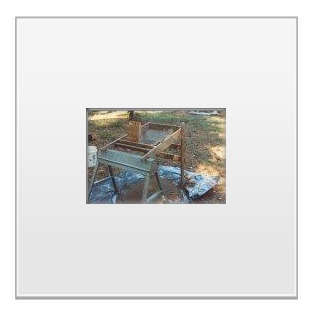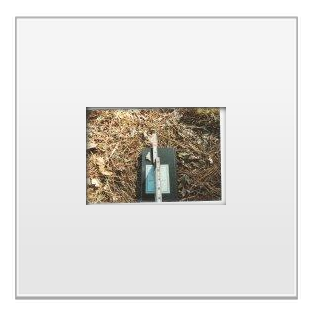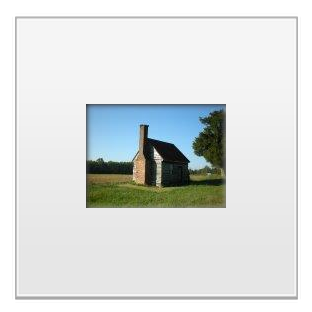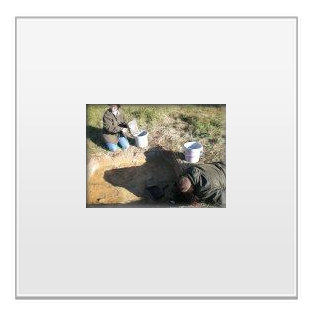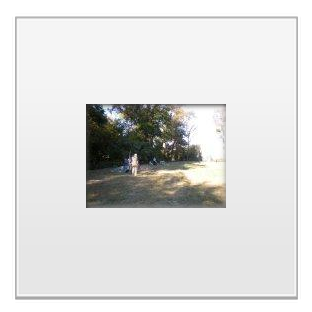Chippokes 07-08 - Passport in Time
Main menu:
Previous Projects > States S-W
Exploration of Chippokes Plantation State Park
George Washington-Jefferson National Forest, Virginia, 2007-2008
By Michael Larkin, PIT Volunteer
A VIEW FROM THE BLUFF AND BEYOND.
Powhatan, his brother Opechancanough and Pocahontas may all have tread where we worked the last two years, And maybe John Smith and his crew rested there too, when they travelled up and down the James River in the small boat called a Shallop, during their voyage of discovery in 1608. We were on Chippokes Plantation, State Park, Virginia, in 07 and 08. The site is, as the crow flies, about 6 miles south west from Jamestown that celebrated its 400 anniversary in 2007. It is not difficult to presume that Powhatan and the others visited there at one time or another, because we were in such close proximity to Jamestown. There on bluffs overlooking the river, we found evidence of activity from the 17 century and for many years before, probably the Early and Middle Woodland periods of Native Americans.
The plantation is a story in itself, but we were on a quest to find the undocumented, but known archaeological resources known to exist there. On the Native American site, located on a high bluff above the James River photo 1, we began shovel test units and test squares. Not too long after a few test squares had been created, artifacts began to appear, especially those near the crest of the bluff. One could only speculate on how many of them, were lost to erosion of the hillside into the river. The elevation of the area is about 785 feet above sea level. The bluff is about 50 feet above the low tide line of the river.
Pottery and a bevy of flakes from lithic reduction began to show up on our reciprocating screens, photo 2. From the square I worked in, we found a beautiful white projectile point, referred to in Wm. J. Hranicky and Floyd Painter's book "A Guide to the Identification of Virginia Projectile Points" as a Yadkin point, see photo 3. The point received its name from where the design originated, i.e. the Yadkin River area of North Carolina which is approximately 250 miles southwest from Chippokes. Hence, it is fair to assume that there was active trading activity and travel conducted between the Native American societies of each area.
In addition, a post hole began to show in the square. Its contents were removed in 08 and were sent to a lab for analysis.
After completion at the site on the 1st bluff, we moved west to a farm that was recently donated and added to the state park. Our unit centered its work on a set of former slave cabins, see photo 4 for one that is still standing. After a survey and one shovel test pit that revealed a midden of oyster shells along side the cabin, we installed a line down the perimeter of a soybean field to the east from the standing cabin. Shovel test pits were flagged and our efforts were rewarded. We found the vestiges of probably a minimum of 5 more cabins, because we found a cabin support pillar on the easternmost pit. The results of our digging and sifting were some bricks, decorated pottery, a nail or two and some oyster shells, all of which indicated human activity. In front of the existing cabin a series of brick steps were found.
Another party centered their search on bluff number 2 over the river. It lies near a swimming pool and has a beautiful green lawn, photo 5. The aforementioned spot became a rich archeological cluster. As described by the archs Mr. Mike Madden of the USA Forest Service and Dr. Mike Barber our State Archeologist, in all likelihood it was a military mustering area.
It may have been used by British officers and soldiers during the massacre of colonial settlers in either 1622 or 1642. The artifacts found ranged from a 69 caliber lead ball to pipe stems.
A successful trip was had by all because our efforts added more knowledge to three eras of our nation. We had the pleasure of digging with the author, Mrs. Connie Rapallo who wrote the book "Dark Enough to see the Stars in a Jamestown Sky". We enjoyed home made soup and bread made by a volunteer, good invigorating weather, camaraderie and the pleasure of meeting new friends.

